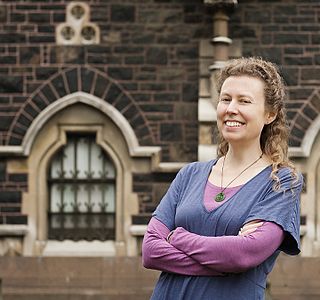Related Research Articles

Radio broadcasting began in New Zealand in 1922, and is now dominated by almost thirty radio networks and station groups. The Government has dominated broadcasting since 1925, but through privatisation and deregulation has allowed commercial talk and music stations to reach large audiences. New Zealand also has several radio stations serving Māori tribes, Pasifika communities, ethnic minorities, evangelical Christians and special interests.

William Manhire is a New Zealand poet, short story writer, emeritus professor, and New Zealand's inaugural Poet Laureate (1997–1998). He founded New Zealand's first creative writing course at Victoria University of Wellington in 1975, founded the International Institute of Modern Letters in 2001, and has been a strong promoter of New Zealand literature and poetry throughout his career. Many of New Zealand's leading writers graduated from his courses at Victoria. He has received many notable awards including a Prime Minister's Award for Literary Achievement in 2007 and an Arts Foundation Icon Award in 2018.

Sir Ernest Marsden was an English-New Zealand physicist. He is recognised internationally for his contributions to science while working under Ernest Rutherford, which led to the discovery of new theories on the structure of the atom. In Marsden's later work in New Zealand, he became a significant member of the scientific community, while maintaining close links to the United Kingdom.

The Rutherford Medal is the most prestigious award offered by the Royal Society of New Zealand, consisting of a medal and prize of $100,000. It is awarded at the request of the New Zealand Government to recognize exceptional contributions to the advancement and promotion of public awareness, knowledge and understanding in addition to eminent research or technological practice by a person or group in any field of science, mathematics, social science, or technology. It is funded by the New Zealand government and awarded annually.

The Royal Society Te Apārangi is a not-for-profit body in New Zealand providing funding and policy advice in the fields of sciences and the humanities. These fundings are provided on behalf of the New Zealand Ministry of Business, Innovation and Employment.

Timothy Raymond Naish is a New Zealand glaciologist and climate scientist who has been a researcher and lecturer at Victoria University of Wellington and the director of the Antarctic Research Centre, and in 2020 became a programme leader at the Antarctic Science Platform. Naish has researched and written about the possible effect of melting ice sheets in Antarctica on global sea levels due to high CO2 emissions causing warming in the Southern Ocean. He was instrumental in establishing and leading the Antarctica Drilling Project (ANDRILL), and a Lead Author on the Intergovernmental Panel on Climate Change (IPCC) 5th Assessment Report (2014).
Robert Jack was a Scottish-born physicist, professor and Dean of the Faculty of Arts and Science, University of Otago, and pioneer of radio broadcasting, New Zealand.

Peter John Barrett is a New Zealand geologist who came to prominence after discovering the first tetrapod fossils in Antarctica in 1967.
The Marsden Medal is a yearly award given by the New Zealand Association of Scientists. It is named after Sir Ernest Marsden and honours "a lifetime of outstanding service to the cause or profession of science, in recognition of service rendered to the cause or profession of science in the widest connotation of the phrase." It rivals the Rutherford Medal from the Royal Society of New Zealand.

Christine Coe Winterbourn is a New Zealand biochemist. She is a professor of pathology at the University of Otago, Christchurch. Her research in the biological chemistry of free radicals earned her the 2011 Rutherford Medal and the Marsden Medal, the top awards from each of New Zealand's two top science bodies.

Nancy Bertler is a German-New Zealand Antarctic researcher. She has led major initiatives to investigate climate history using Antarctic ice cores, and best known for her leadership of the Roosevelt Island Climate Evolution Programme (RICE). She is a full professor at the Antarctic Research Centre at Victoria University of Wellington in New Zealand.

Christina Hulbe is an American Antarctic researcher, and as of 2016 serves as professor and Dean of Surveying at the University of Otago in New Zealand. She was previously Chair of the Geology Department at Portland State University in Portland, Oregon. She leads the NZARI project to drill through the Ross Ice Shelf and is the namesake of the Hulbe glacier.

Victoria Metcalf is an Antarctic researcher based in New Zealand, best known for her work on Antarctic fishes and invertebrates. She was awarded the 2006 Zonta Science Award.

Rebecca Katherine Priestley is a New Zealand academic, science historian, and writer. She is Professor in Science in Society at Victoria University of Wellington.
The Prime Minister's Science Prizes are awarded yearly by the Prime Minister of New Zealand. They were first awarded in 2009 in order to raise the profile and prestige of science among New Zealanders. The 2019 awards were presented in early 2020.
Agnieszka Fryckowska is a New Zealand meteorologist and Antarctic base manager who has worked with the British Antarctic Survey (BAS). Fryckowska has spent five winters in Antarctica. She is a recipient of the Polar Medal.
Laurence Fearnley is a New Zealand short-story writer, novelist and non-fiction writer. Several of her books have been shortlisted for or have won awards, both in New Zealand and overseas, including The Hut Builder, which won the fiction category of the 2011 NZ Post Book Awards. She has also been the recipient of a number of writing awards and residencies including the Robert Burns Fellowship, the Janet Frame Memorial Award and the Artists to Antarctica Programme.

Gabby O'Connor is an Australian Installation Artist based in Wellington, New Zealand.

Natalie Robinson, a New Zealand Antarctic researcher. She is based at the National Institute of Water and Atmospheric Research in New Zealand. She led the final two K131 Science Events on the sea ice of McMurdo Sound, Antarctica. In 2023, she was appointed Deputy Director of the N.Z. Antarctic Science Platform.

The Dodd-Walls Centre for Photonic and Quantum Technologies is a New Zealand Centre of Research Excellence, established in 2015, hosted by the University of Otago, and composed of researchers in six New Zealand universities as well as partner institutions in the US, United Kingdom, and Singapore. It does fundamental research on the quantum nature of matter, the physics and optics of light, and the manipulation of individual photons. New knowledge and applications are commercialised for industries including agritech, medicine, and civil engineering.
References
- ↑ Noted. "Science on Ice by Veronika Meduna – review - The Listener". Noted. Retrieved 6 August 2017.
- ↑ "Paying tribute to a science reporting star". 29 July 2016. Retrieved 6 August 2017.
- ↑ "'The Conversation' Website Appoints NZ Editor Veronika Meduna". Scoop News. Retrieved 6 August 2017.
- ↑ "Veronika Meduna". Radio New Zealand . Retrieved 7 August 2017.
- ↑ "Science on Ice: Discovering the Secrets of Antarctica - The University of Auckland". www.press.auckland.ac.nz. Retrieved 6 August 2017.
- ↑ "Winston Churchill Memorial Trust 2021 fellowships and their research reports". Department of Internal Affairs. Retrieved 30 December 2021.
- ↑ Veronika, Meduna (2015). Towards a warmer world : what climate change will mean for New Zealand's future. Wellington, New Zealand. ISBN 9780908321735. OCLC 930367343.
{{cite book}}: CS1 maint: location missing publisher (link) - ↑ Veronika., Meduna (2012). Science on ice : discovering the secrets of Antarctica. Auckland, N.Z.: Auckland University Press. ISBN 9781869405830. OCLC 767879443.
- ↑ Meduna, Veronika; Priestley, Rebecca (2008). Atoms, Dinosaurs & DNA: 68 Great New Zealand Scientists. Random House New Zealand. ISBN 9781869419547.